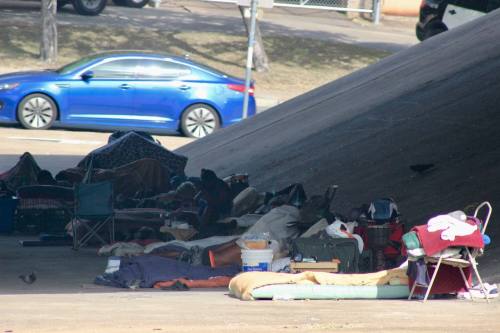Update: Aug. 28, 3:01 p.m. — University of Texas Police Chief David Carter wrote a letter to Mayor Steve Adler and Austin City Council on Wednesday requesting the city prohibit camping in areas along the entire of perimeter of the UT campus as well as in the West Campus neighborhood.
Carter wrote that as the city seeks housing and and support services for the homeless, it must "recognize that the interface of young students and some subsets of the homeless community have created potential dangers."
"This view is not based on discriminatory practices, but, rather, on real-world experiences of members of the UT community," Carter wrote in the letter.
Adler, District 5 Council Member Ann Kitchen and District 9 Council Member Kathie Tovo proposed barring camping in areas including the Drag in their homelessness action plan published on Aug. 20.
Original story, published Aug. 20 — Designating specific areas to encourage homeless encampments is a bad idea according to city of Austin staff, and the mayor and some City Council members want to place heavier restrictions on camping throughout the city, as the Austin community continues to grapple with a growing homeless population.
The calls from city officials come two months after City Council voted to
decriminalize public camping throughout the city, a controversial decision that piqued widespread attention.
During that June 20 meeting, some City Council members proposed city staff designate specific areas in each City Council district where camping is encouraged, rather than approving a general camping ban lift. Despite the proposal, City Council moved forward with its decision but told city staff to come back with some recommended areas in August.
However, city staff has refused City Council’s request. In a memo sent last week, Assistant City Manager Rodney Gonzales said staff would “respectfully not bring forth recommendations for authorized encampments” since the move would chafe against the city’s housing-first strategy. Staff also cited concerns from the National Alliance to End Homelessness, a D.C.-based firm with which the city is consulting, on authorized encampments.
“Rather the focus will continue to be on housing first and the deployment of actions targeted toward rapid rehousing, emergency shelters, low-barrier housing-focused shelter, and permanent supportive housing,” Gonzales wrote.
Such campsites require heavy city resources, and research showed they provided little progress toward addressing the homelessness issue in cities where they are provided, Gonzales said at the Aug. 20 City Council work session. He said city resources would be better put toward creating more permanent supportive housing.
District 5 City Council Member Ann Kitchen, who initially proposed staff make such recommendations, said she still thought City Council needed to move forward on the camping issue on their own.
Tightening camping restrictions
On Aug. 20, Kitchen, with City Council Member Kathie Tovo—the city’s downtown representative—and Mayor Steve Adler, published an action plan to address homelessness. The plan included proposals to significantly restrict camping throughout the city of Austin.
“We don’t want camping in public places,” was the second of five principles and goals proposed through the plan. It also suggests that restrictions on camping should continue to tighten as the city provides more housing and shelter space in the future for those experiencing homelessness.
However, the mayor and council members proposed immediate restrictions in a wide range of general areas such as sidewalks, paths, trails, outside shelters and navigation centers, under bridges and adjacent to roadways and transit facilities. Specifically, they say camping should not be allowed along Congress Avenue; Second and Sixth streets; along the Drag; and outside the Austin Resource Center for the Homeless, also known as the ARCH.
The plan also proposes allowing neighborhoods and organizations to ask the city to restrict camping in specific places if the neighborhood or organization helps the city provide a better, safer and more desirable place for the homeless in that area.
Where camping is allowed, the plan proposed imposing further restrictions on the size of the tents and structures and the number of belongings a person can have. The plan could also require campers to help keep the area clean and free of litter.
In a text message to
Community Impact Newspaper Aug. 20, District 4 Council Member Greg Casar, who helped provide input for the plan, said it only lays out proposals, and it does not suggest all of the recommendations will be approved by City Council. Casar also advised caution in carefully tailoring rules to ensure they are not discriminatory.
Adler said during an Aug. 20 work session that he understood the issue required much more than a few elected officials getting together to try and find solutions on their own. Kitchen acknowledged it only represents “the beginning level of thinking.”
Amid the heavier restrictions, the plan lays out a social compact that community members “should not tell people they can’t be in certain public places if we’re not able to tell them where, alternatively, there’s a viable place for them to be.”
In the proposal, the mayor and city council members doubled down on their commitment to providing more permanent housing, shelter space, emergency resource centers, and facilities such as public bathrooms, water fountains and storage lockers. The plan says City Council will be taking further action on camping on other homelessness initiatives in September.





